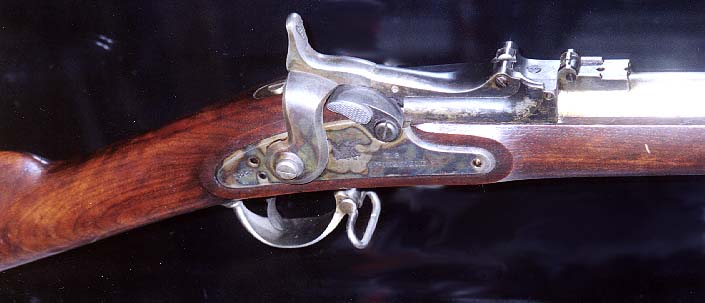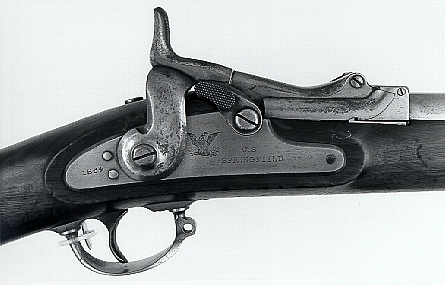Model 1865
Model 1865 Rifles and Short Rifles
 |
|---|
Model 1865 Rifle
in the Tojhusmuseet (Arsenal Museum), Copenhagen, Denmark. An Ordnance
letter dated April 18, 1866, to the Commanding Officer at the Springfield
Armory states: You will be pleased to prepare and issue properly packed
for presentation to the Danish Government, two Springfield rifle muskets
with 1000 copper cartridges for each. One of the muskets to be altered
on
Allin's plan, like the 5000 ordered; and one with Allin's latest
improvements [M66]. When ready, they will be sent to H. Dolluer
Esq.,
Consul for Denmark, 181 Front Street, New York. The lock
plate date is dated 1862. Also, the right side of the breech block extends
above the front
of the receiver like a number of experimental First Allin's at
Springfield. There is one illustrated in Book I. Photograph supplied by
Ed
Hull. |
|---|
|
Model 1865 Rifle
| Overall Length | 56 Inches |
|---|
| Barrel Length (in bore) | 37.7 Inches |
|---|
| Cleaning Rod Length | 39 5/8 Inches, swell and
threaded |
|---|
| Muzzle Diameter | .772 -.778 Inches |
|---|
| Rifling | 3 Lands and Grooves |
|---|
| Caliber | .58 Rimfire .58-60-500 Cartridge |
|---|
| Barrel Bands | 3, M61 Flat bands, 11 Inches apart |
|---|
| Cartouches | 2, Rect. between bolt heads & oval ESA
behind bolt heads |
|---|
| Breech Block | Not Stamped |
|---|
| Firing Proof | None |
|---|
| Lock Plate | Dated 1865 & Milled |
|---|
| V/P/Eagle/p stamp | Possibly CW Eagle |
|---|
| Front sight | 1 1/4" from muzzle, 5/16" long |
|---|
| Rear Sight | M65 |
|---|
Model 1865
Rifle | NRA Very Good =$2,500
NRA Excellent =
$4,500 |
Model 1865
Short Rifle | NRA Very Good = $?
NRA
Excellent =
$? |
Model 1865 Rifle
The Civil War was drawing to a close, but far from over, when the War
Department requested that the Ordnance Department develop a breech
loading rifle for
the military. To fulfill this request, the Ordnance Department sent
requests for prototype arms to all the major arms
manufacturers in the
world and to anyone who would like to submit a test gun for trial. A
number of private and commercial arms were received
along with several submitted by Springfield armorers.
After a considerable amount of prototype testing, the breechloader
submitted by Erskine S. Allin, Master Armorer at
Springfield, was selected for its
simplicity. Also, it could be inexpensively assembled using many
parts
from CW
muskets. At this time, and for many years after the War, getting funds
for new ordnance projects was a major problem.
5,000 of Mr.Allin's rifles were made and given the
nickname "First Allin."
The gun design was based on using Model 1861 muskets for its
construction. Only the stocks
and barrels had to be modified. The breech of the barrel was opened and
fitted with a breech block which hinged forward, thus the name "trapdoor."
The stock had to be cut to
accept the ejector and
extractor mechanisms. This process left only a very thin portion of
wood covering the mechanism on the lockplate side of the stock. If a rifle
had been used in service, this piece of wood is usually missing. The rifle
was chambered for .58-60-500 rimfire cartridges. CW locks, stocks,
barrels, trigger assemblies and bands were
used in their
production. This made the actual production cost ($5.00) far
less than the cost of a new
rifle.
It soon became apparent that many of the small working parts in the
breech system were
not going to have a long service life, and the action was too complicated
for normal service use. Therefore, before the M65 production
order was completed, the less complex
M66 rifle,"Second Allin," was already being tested.
The
Model 1865 rifle quickly became obsolete and most of them were sold
in the 1870s
to several American arms dealers. At the time, there was a large demand
in the US,
for shorter cadet style
rifles. To satisfy this need,
these dealers cut the barrels and stocks to make short rifles with 33" and
36" barrel lengths.
Likewise, the stock wrists were often thinned for cadet use. These
altered
guns have marginal
value and have caused the remaining few unaltered rifles to rapidly climb
in
value.
Model 1865 Short Rifle
The Model 1865 Prototype Short Rifle was not produced in quantity. The one
featured here is
from the collection at the Springfield Armory NHS. It is a short rifle
with a full butt plate and assembled
using a M63 Type I stock and M63 hardware.
Very few records exist on the gun and a value
has not been established.
For additional photographs, descriptions and
specifications for the above
rifles see:
The .45-70 Springfield-Book II-1865-1893.


